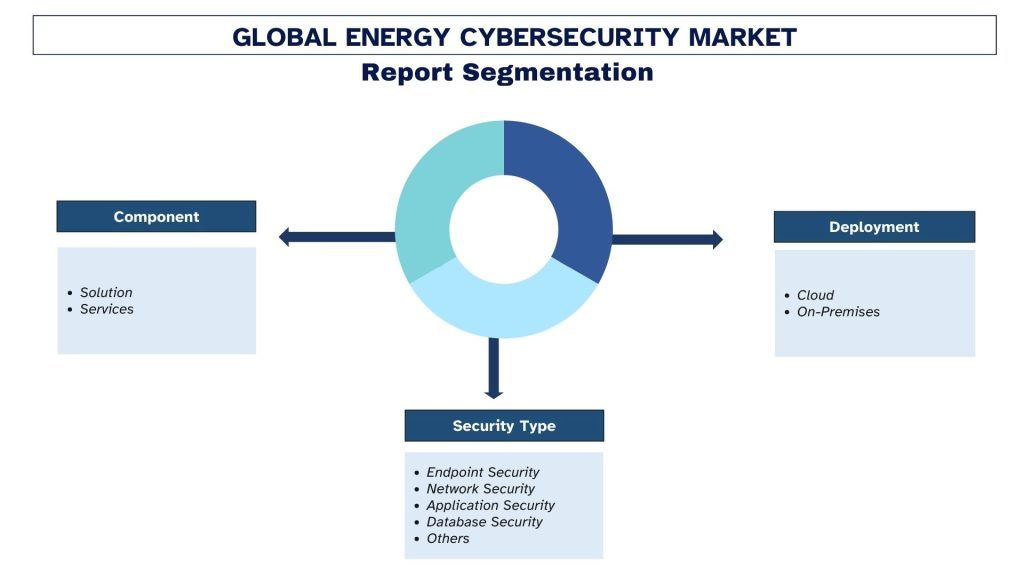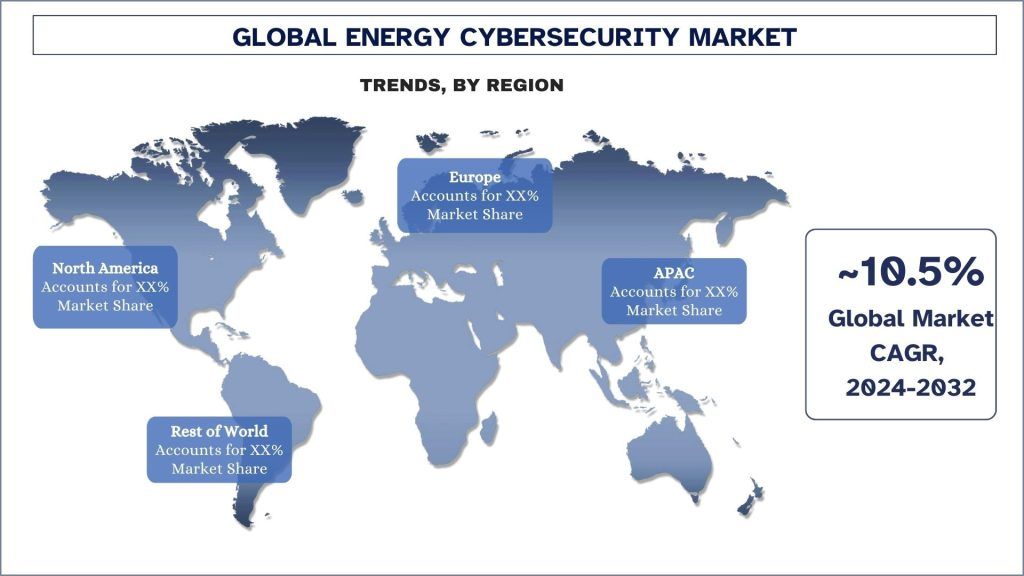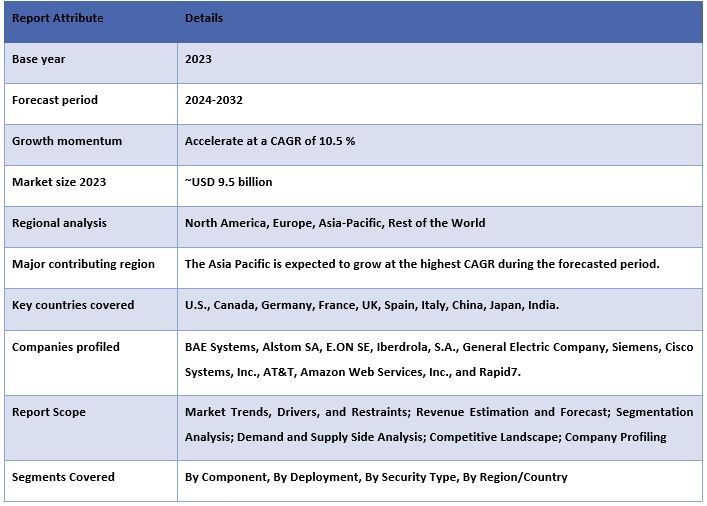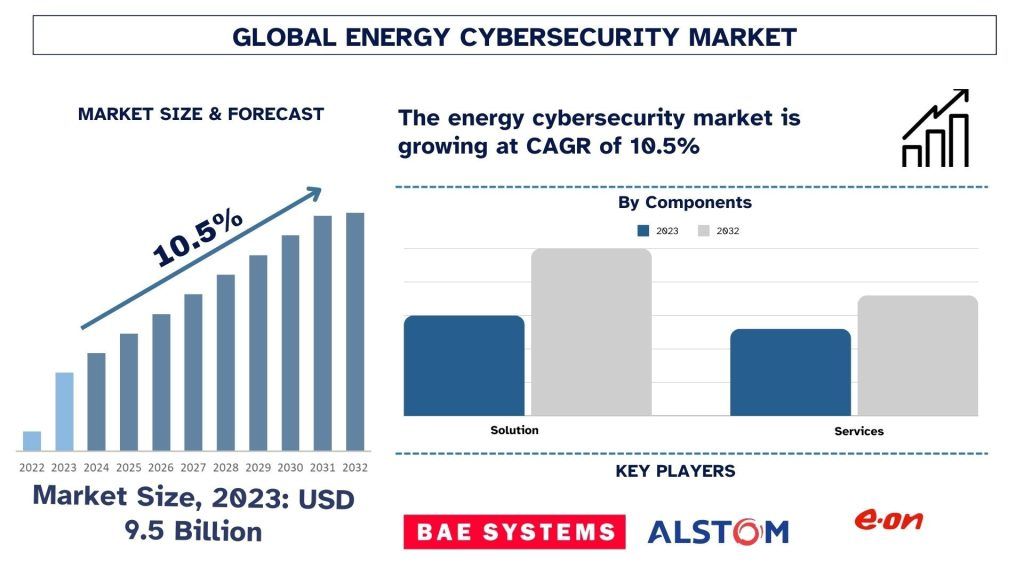- Home
- About Us
- Industry
- Services
- Reading
- Contact Us
Energy Cyber Security Market: Current Analysis and Forecast (2024-2032)
Emphasis on Component (Solutions and Services), Deployment (Cloud and on-premises), and Security Type (Endpoint Security, Network Security, Application Security, Database Security, Others) Region/Country
Energy Cybersecurity Market Size & Forecast
The Energy Cybersecurity market was valued at approximately USD 9.5 Billion in 2023 and is expected to grow at a robust CAGR of around 10.5% during the forecast period (2024-2032). The growth of the energy cyber security market is driven by increasing cyber threats, digitalization of energy infrastructure, government regulations, and the rise of IoT and smart grids.
Energy Cybersecurity Market Analysis
Energy cyber security refers to the technologies, processes, and practices used to protect energy systems and infrastructure from cyber threats. The energy cyber security market includes a range of products and services, such as security software, hardware, and consulting services, that are designed to secure energy infrastructure.
The energy sector is an essential component of modern society, providing the power necessary to support economic, social, and political activity. However, the growing reliance on digital technologies and interconnected systems has also made the energy sector more vulnerable to cyber-attacks. The increasing number of cyber-attacks on energy systems and infrastructure has created a pressing need for effective energy cyber security measures to protect critical infrastructure and prevent large-scale disruption. For instance, according to AAG between 2017 and 2021, reported cybercrime increased by 153%, from 27,829 cases in 2017 to 70,288 cases in 2021. Furthermore, the threat of cyber-attacks on energy infrastructure is significant and multifaceted. Cybercriminals can use various methods to gain access to energy systems and disrupt operations, including malware, phishing, social engineering, and physical attacks on infrastructure. Additionally, cyber-attacks can target various aspects of energy systems, including power plants, transmission and distribution networks, and control systems.
Energy Cybersecurity Market Trends
This section discusses the key market trends influencing the Energy Cybersecurity segments as identified by our research experts.
Network Security Type Transforming Industry
Based on security type, the market is segmented into endpoint security, network security, application security database security, and others. Network security is crucial for energy cyber security as it helps safeguard energy systems from cyber threats. The growing adoption of network security is mainly attributed to the growing number of cyber-attacks via connectivity and network, energy systems rely on interconnected networks to operate, but these networks also create vulnerabilities that can be exploited by attackers to disrupt operations, damage equipment, and compromise sensitive data.

North America is expected to Dominate the Market.
The growth of the energy cyber security market in North America is driven by several key factors, including the increasing number of cyberattacks targeting critical infrastructure such as power grids and energy systems. The widespread adoption of smart grids and IoT devices in the energy sector has introduced new vulnerabilities, making cybersecurity a top priority for energy companies. Government regulations, such as the North American Electric Reliability Corporation (NERC) Critical Infrastructure Protection (CIP) standards, are further pushing companies to enhance their cybersecurity measures. Additionally, the growing use of renewable energy sources and digitalization across the energy supply chain are driving investments in advanced security solutions to protect these assets from emerging threats.

Energy Cybersecurity Industry Overview
Energy Cybersecurity is competitive, with several global and international market players. The key players are adopting different growth strategies to enhance their market presence, such as partnerships, agreements, collaborations, new product launches, geographical expansions, and mergers and acquisitions. Some of the major players operating in the market are BAE Systems, Alstom SA, E.ON SE, Iberdrola, S.A., General Electric Company, Siemens, Cisco Systems, Inc., AT&T, Amazon Web Services, Inc., and Rapid7. Several M&As along with partnerships have been undertaken by these players to facilitate customers with hi-tech and innovative products/technologies.
Energy Cybersecurity Market News
- For instance, in 2024, The Department of Energy announced a $45 million investment into cybersecurity research for the energy sector, including projects on artificial intelligence detection and response and quantum communication for the grid.
Energy Cybersecurity Market Report Coverage

Reasons to buy this report:
- The study includes market sizing and forecasting analysis validated by authenticated key industry experts.
- The report presents a quick review of overall industry performance at one glance.
- The report covers an in-depth analysis of prominent industry peers with a primary focus on key business financials, product portfolios, expansion strategies, and recent developments.
- Detailed examination of drivers, restraints, key trends, and opportunities prevailing in the industry.
- The study comprehensively covers the market across different segments.
- Deep dive regional level analysis of the industry.
Customization Options:
The Global Energy Cybersecurity can further be customized as per the requirement or any other market segment. Besides this, UMI understands that you may have your own business needs; hence, feel free to connect with us to get a report that completely suits your requirements.
Table of Content
Research Methodology for the Energy Cybersecurity Market Analysis (2022-2032)
Analyzing the historical market, estimating the current market, and forecasting the future market of the global Energy Cybersecurity market were the three major steps undertaken to create and analyze the adoption of Energy Cybersecurity in major regions globally. Exhaustive secondary research was conducted to collect the historical market numbers and estimate the current market size. Secondly, numerous findings and assumptions were taken into consideration to validate these insights. Moreover, exhaustive primary interviews were also conducted, with industry experts across the value chain of the global Energy Cybersecurity market. Post assumption and validation of market numbers through primary interviews, we employed a top-down/bottom-up approach to forecasting the complete market size. Thereafter, market breakdown and data triangulation methods were adopted to estimate and analyze the market size of segments and sub-segments of the industry. Detailed methodology is explained below:
Analysis of Historical Market Size
Step 1: In-Depth Study of Secondary Sources:
A detailed secondary study was conducted to obtain the historical market size of the Energy Cybersecurity market through company internal sources such as annual reports & financial statements, performance presentations, press releases, etc., and external sources including journals, news & articles, government publications, competitor publications, sector reports, third-party database, and other credible publications.
Step 2: Market Segmentation:
After obtaining the historical market size of Energy Cybersecurity, we conducted a detailed secondary analysis to gather historical market insights and share for different segments & sub-segments for major regions. Major segments are included in the report, such as component, deployment, security type, and region. Further country-level analyses were conducted to evaluate the overall adoption of testing models in that region.
Step 3: Factor Analysis:
After acquiring the historical market size of different segments and sub-segments, we conducted a detailed factor analysis to estimate the current market size of the Energy Cybersecurity market. Further, we conducted factor analysis using dependent and independent variables such as component, deployment, security type, and Energy Cybersecurity regions. A thorough analysis was conducted of demand and supply-side scenarios considering top partnerships, mergers and acquisitions, business expansion, and product launches in the Energy Cybersecurity market sector across the globe.
Current Market Size Estimate & Forecast
Current Market Sizing: Based on actionable insights from the above three steps, we arrived at the current market size, key players in the global Energy Cybersecurity market, and market shares of the segments. All the required percentage shares split and market breakdowns were determined using the above-mentioned secondary approach and were verified through primary interviews.
Estimation & Forecasting: For market estimation and forecast, weights were assigned to different factors including drivers & trends, restraints, and opportunities available for the stakeholders. After analyzing these factors, relevant forecasting techniques i.e., the top-down/bottom-up approach were applied to arrive at the market forecast for 2032 for different segments and sub-segments across the major markets globally. The research methodology adopted to estimate the market size encompasses:
- The industry’s market size, in terms of revenue (USD) and the adoption rate of Energy Cybersecurity across the major markets domestically
- All percentage shares, splits, and breakdowns of market segments and sub-segments
- Key players in the global Energy Cybersecurity in terms of products offered. Also, the growth strategies adopted by these players to compete in the fast-growing market
Market Size and Share Validation
Primary Research: In-depth interviews were conducted with the Key Opinion Leaders (KOLs), including Top Level Executives (CXO/VPs, Sales Head, Marketing Head, Operational Head, Regional Head, Country Head, etc.) across major regions. Primary research findings were then summarized, and statistical analysis was performed to prove the stated hypothesis. Inputs from primary research were consolidated with secondary findings, hence turning information into actionable insights.
Split of Primary Participants in Different Regions
Market Engineering
The data triangulation technique was employed to complete the overall market estimation and to arrive at precise statistical numbers for each segment and sub-segment of the global Energy Cybersecurity. Data was split into several segments and sub-segments after studying various parameters and trends in the component, deployment, security type, and regions of the global Energy Cybersecurity market.
The main objective of the Global Energy Cybersecurity Market Study
The current & future market trends of global Energy Cybersecurity were pinpointed in the study. Investors can gain strategic insights to base their discretion for investments on the qualitative and quantitative analysis performed in the study. Current and future market trends determined the overall attractiveness of the market at a regional level, providing a platform for the industrial participant to exploit the untapped market to benefit from a first-mover advantage. Other quantitative goals of the studies include:
- Analyze the current and forecast market size of the Energy Cybersecurity market in terms of value (USD). Also, analyze the current and forecast market size of different segments and sub-segments.
- Segments in the study include areas of component, deployment, security type, and regions.
- Define and analyze the regulatory framework for the Energy Cybersecurity
- Analyze the value chain involved with the presence of various intermediaries, along with analyzing customer and competitor behaviors of the industry.
- Analyze the current and forecast market size of the Energy Cybersecurity market for the major regions.
- Major countries of regions studied in the report include Asia Pacific, Europe, North America, and the Rest of the World
- Company profiles of the Energy Cybersecurity market and the growth strategies adopted by the market players to sustain in the fast-growing market.
- Deep dive regional level analysis of the industry
Frequently Asked Questions FAQs
Q1: What is the global Energy Cybersecurity's current size and growth potential?
Q2: What are the driving factors for the growth of global Energy Cybersecurity?
Q3: Which segment has the largest share of the global Energy Cybersecurity by security type?
Q4: What are the emerging technologies and trends in global Energy Cybersecurity?
Q5: Which region will dominate global Energy Cybersecurity?
Related Reports
Customers who bought this item also bought












